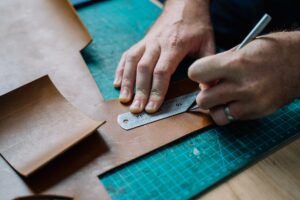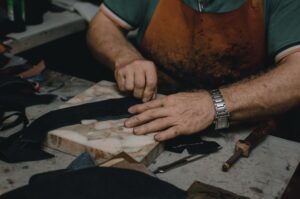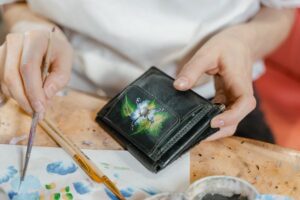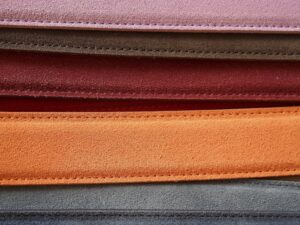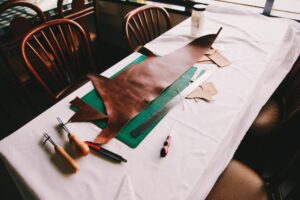
Piercing leather can be a challenging task for those who are not familiar with the proper tools and techniques. Whether you are a beginner looking to add holes to leather for the first time or an experienced leatherworker looking to add precision to your craft, it is important to have the right tools on hand. In this article, we will explore some of the most commonly used tools for piercing leather, including punches, awls, and needles, and discuss their features and capabilities.
How to Determine Which Leather Piercing Tool to Use: 4 Factors
When selecting a tool for piercing leather, it is important to consider the size and shape of the hole you need to create, as well as the thickness and type of leather you will be working with. For example, if you are working with thick leather, you will need a tool that is capable of piercing through the material without bending or breaking. Similarly, if you are working with a fine, delicate leather, you will need a tool that is able to create precise, clean holes without damaging the material.
1. Size
First, it is important to choose a tool that is the appropriate size for the job. For example, if you are trying to create a small, precise hole in fine leather, using a large punch or awl may not give you the desired result. Instead, you might want to use a finer tool, such as a needle or a small punch. On the other hand, if you are working with thicker leather and need to create a large hole, a smaller tool may not be able to handle the job. In this case, you might want to use a larger punch or awl.
2. Material
Another factor to consider is the material of the tool. Many punches, awls, and needles are made of metal, which is strong and durable, but can also be prone to rust if not properly cared for. Some tools, such as awls, are also available in wood or bone, which can be more gentle on the leather and may be more suitable for delicate projects.
3. Design
In addition to the size and material of the tool, it is also important to consider the type of handle the tool has. Some punches and awls have a straight handle, while others have a curved handle or a T-shaped handle. The type of handle you choose will depend on your personal preference and the type of grip you find most comfortable. Some handles may also be more suitable for certain tasks, such as a T-shaped handle for creating decorative patterns or a curved handle for reaching difficult areas.
4. Quality
Finally, it is important to consider the overall quality of the tool. Higher quality tools are often made of higher quality materials and are more precise and durable. While they may cost more upfront, they can save you time and frustration in the long run, as they are less likely to break or wear out quickly.
By considering these factors when selecting a tool for piercing leather, you can ensure that you have the right tool for the job, which will result in better, more professional-looking results in your leather projects.
Tools for Piercing Leather
Leather Punch
One of the most common tools used for piercing leather is the punch. Punches come in a variety of sizes and shapes, and are designed to cut clean, precise holes through leather. The size of the punch is determined by the diameter of the hole it is intended to create, and punches are usually available in sizes ranging from 1/16” to 1”. There are several types of punches, including round punches, square punches, and oblong punches, each of which is suited to different tasks.
Round punches are the most common type of punch, and are used to create circular holes in leather. They are available in a wide range of sizes, and are typically used for tasks such as creating holes for lacing, adding grommets, or creating decorative patterns. Square punches are used to create square or rectangular holes, and are often used for tasks such as creating holes for belt buckles or attaching hardware. Oblong punches are used to create elongated holes, and are often used for tasks such as creating holes for straps or adding decorative stitching.
Awl
In addition to punches, another common tool for piercing leather is the awl. Awls are thin, pointed tools that are used to create holes in leather by piercing and scraping away the material. They are available in a variety of shapes and sizes, and are often used for tasks such as marking holes for stitching or creating precise holes for lacing. Some awls have a straight, pointed tip, while others have a curved or angled tip, which can be useful for reaching difficult areas or creating angled holes.
Needles
Needles are another tool that can be used for piercing leather. Needles come in a variety of sizes and shapes, and are typically used for tasks such as sewing or lacing leather. The size of the needle is determined by the thickness of the thread or lace it is intended to be used with, and needles are usually available in sizes ranging from very fine to very thick. The type of needle used will depend on the task at hand, and there are several different types of needles available, including sewing needles, beading needles, and lacing needles.
Other options
In addition to punches, awls, and needles, there are several other tools that can be used for piercing leather. For example, hole punches are a type of punch that is specifically designed for creating holes in leather, and are often used for tasks such as adding grommets or creating holes for lacing. Leather punches are another type of tool that can be used for piercing leather, and are similar to hole punches in that they are designed specifically for piercing leather. Leather punches are often used for tasks such as adding holes to belts or creating decorative patterns.
In conclusion, punches, awls, and needles are all useful tools for piercing leather, and the right tool for the job will depend on the size and shape of the hole you need to create, as well as the thickness and type of leather you are working with. Whether you are a beginner or an experienced leatherworker, having the right tools on hand is essential for achieving clean, precise holes in your leather projects. With the right tools and a little practice, you will be able to create professional-quality holes in leather with ease.

